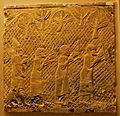Jewish diaspora facts for kids
The Jewish diaspora or exile is when Jewish people moved away from their original homeland, the Land of Israel. They then settled in many other parts of the world.
In the Hebrew Bible, "Exile" describes what happened to the Israelites. They were taken from the Kingdom of Israel in the 8th century BCE. Later, the Judahites from the Kingdom of Judah were also taken away in the 6th century BCE. While they were in exile, the Judahites started to be called "Jews." The Book of Esther mentions "Mordecai the Jew" as the first time this word appears in the Bible.
Contents
What Is the Jewish Diaspora?
The word "diaspora" means "scattering" or "dispersion." It describes groups of people who live outside their original homeland. For Jewish people, it means their history of living in many different countries around the world. Even though they lived far apart, they often kept their traditions and faith.
Early Exiles: Ancient Times
The first major exiles happened a very long time ago. These events are important parts of Jewish history.
The Assyrian Exile (8th Century BCE)
Around 722 BCE, the powerful Assyrian Empire conquered the Kingdom of Israel. This kingdom was in the northern part of the Land of Israel. The Assyrians forced many Israelites to leave their homes. They moved them to other parts of the Assyrian Empire. This was done to prevent rebellions. These Israelites became known as the "Ten Lost Tribes."
The Babylonian Exile (6th Century BCE)
Later, in 586 BCE, the Babylonian Empire conquered the Kingdom of Judah. This kingdom was in the southern part of the Land of Israel. The Babylonians destroyed the First Temple in Jerusalem. They also forced many Judahites to move to Babylon. This period is known as the Babylonian Exile.
After about 70 years, some Judahites were allowed to return to Jerusalem. They rebuilt the Temple. However, many chose to stay in Babylon. This was one of the first big Jewish communities outside the Land of Israel.
Life in the Diaspora
Living in the diaspora meant Jewish people had to adapt to new cultures. They often lived in communities together. This helped them keep their customs, language, and religious practices.
Challenges and Contributions
Jewish communities faced many challenges. They sometimes experienced persecution or were forced to leave their homes again. Despite this, they also made many important contributions. They shared knowledge, helped trade, and enriched the cultures of the lands they lived in.
The Roman Exile (1st Century CE)
Another major event was the Roman conquest of Judea. In 70 CE, the Roman Empire destroyed the Second Temple in Jerusalem. Many Jews were killed or enslaved. Others were forced to leave the land. This led to a much larger scattering of Jewish people across the Roman Empire and beyond. This event greatly increased the size of the Jewish diaspora.
Modern Diaspora
Over centuries, Jewish communities spread across Europe, North Africa, and Asia. They developed different cultures and languages. For example, Ashkenazi Jews lived mainly in Eastern and Central Europe. Sephardic Jews lived in Spain, Portugal, and North Africa.
Return to the Homeland
In the 19th and 20th centuries, a movement called Zionism grew. It called for Jewish people to return to their ancient homeland. This led to the creation of the modern State of Israel in 1948. Many Jewish people have since moved to Israel. However, large Jewish communities still thrive around the world, especially in the United States and Europe.
Images for kids
-
Copy of relief panel from the Arch of Titus in the Nahum Goldmann Museum of the Jewish People, depicting the triumphal parade of Roman soldiers celebrating Judaea Capta ("Judaea is enslaved/conquered") and leading newly enslaved Jews, while displaying spoils of the siege of Jerusalem.
See also
 In Spanish: Diáspora judía para niños
In Spanish: Diáspora judía para niños






